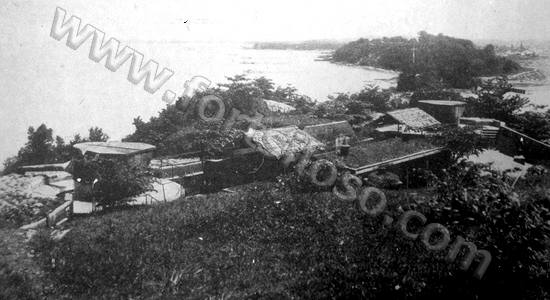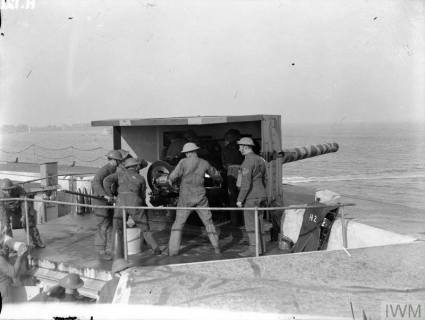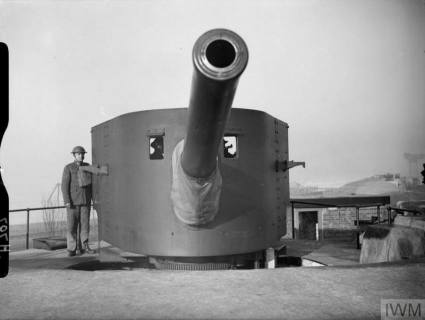Fort Siloso: The Guns of Singapore - Mark VII 6 Inch BL Gun


Mark VII 6 Inch BL Gun on Mark II Centre Pivot Mounting (CPM), with Mark IV Shield
The shell is being rammed, and a propellant cartridge is ready to place into the breech
Photo: Imperial War Museum
The 6 Inch B.L. Gun formed the backbone of British coast defence gun batteries around the world from its inception in the 1880s until the disbandment of coast artillery units in 1956. To defend Singapore, Mark VII Guns on Mark II CPM were emplaced at; Pasir Laba Battery, Labrador Battery, Fort Siloso, Serapong Battery, Fort Silingsing, Beting Kusah Battery, the Changi Battery, and the Pengerang Battery in Johore.
The guns at Pasir Laba and Serapong, had the Mark 1 Shield. Labrador and Beting Kusah had locally made Shield Extensions. The Changi and Silingsing guns had the Mark IV Shield. I don’t know what shields the Pengerang guns had.

The Gun Barrel
Gun Barrel
The gun barrel with its breech assembly weighed 6 tons, 10 cwt. 2 qrs. 19 lbs (7654 kg). The barrel was constructed of steel tubes, layers of steel wire, a jacket, breech bush and breech ring.
Breech
The guns are fitted with a “Single Motion Breech Mechanism.” At one pull on a lever the breech screw is automatically unlocked and swung into the loading position. After loading, one push on the same lever closes the breech screw and locks it.
Carriage and Mounting
The gun carriage includes a cradle which is a ‘U’ shaped casting to hold the barrel, hydraulic recoil system, a sighting platform, traversing, elevating and elevation indicator gears. The carriage allows the barrel to elevate to 16° and to depress to 10° when the gun shield is fitted. The Gun Carriage was fitted with two gun sights, a Rocking Bar Sight, and an Automatic Sight. The carriage was fixed to a CPM, which was bolted to 28 long bolts embedded in concrete. The bolts and the concrete were called a ‘Holdfast’. The bolts had to be very carefully and accurately set in the concrete in order for the CPM to be fitted correctly.

Fort Siloso 1930s
Shield
The Mark IV Shields and the locally made extensions afforded some front, side and overhead protection to the gunners operating the gun.
Ammunition
The gun fired Armour Piercing (AP) or High Explosive (HE) shells, propelled by cordite cartridges. It is likely that the batteries had a small supply of inert shells to fire ‘Bring To’ or stopping across the bows of ships that needed to be stopped for examination or to prevent them from entering mine fields. It is known that such shells were held in Singapore.
The AP shells had a bursting charge in them. Once they penetrated the target, the charge would split the shell into large fragments designed to smash machinery and men alike. Shells weighed 100 lbs (45.35 kg). Armour piercing shells had a fuze fitted in the centre of the base and were fitted with a lightweight thin steel or aluminium alloy ballistic cap to decrease air resistance. On impact, the tough steel shell would pass through it like a hot knife through butter. HE shells had the fuze in the nose.
A propellant cartridge consisted of two half-charges, each of 11½ lbs (5·2 kg) of cordite laced together in a silk cylindrical bag. An igniter charge is at one end of the cartridge. This is in a thin disc of shaloon (a thin twilled worsted loosely woven material). When inserted in the breech, the igniter must be at the breech end. Silk was used as it does not build up a dangerous static charge, nor does it absorb moisture. Moisture does not affect cordite, but it does affect the igniter. A reduced charge could be used for practice, but a full charge was always used in action. Cartridges were stored in sealed zinc canisters. These did not rust or cause any sparks.
The igniter was set of by a Vent Tube inserted in the breech. These looked rather like a shotgun cartridge. Tubes could be fired either electrically or by percussion.
Gun Detachment
The detachment manning each gun composed of thirteen men. These were supported by more men in the Magazine, sending up shells and cartridges as required.
The gun detachment’s duties were:
1. In command and ramming the shell.
2. Operating the breech.
3 and 5. Loading shell and cartridge.
4. Ramming the shell.
6 and 8. Preparation of cartridges.
7 and 9. Preparation of shells.
Auto-Sight-Layer. Auto-sight and the gun training arc.
Rocking Bar Layer. Rocking Bar Sight and Elevation indicator.
Setter for Training. Training Dial and Auto-Sight.
Setter for Range. Range Dial and Rocking Bar Sight.
Behind each gun, set into in the concrete ring, were several recesses, each with steel doors. In these shells and cartridges were stored so that they were immediately available should the need arise.
A well drilled gun team could fire seven rounds per minute. The maximum range of the Mark VII gun on a Mark 2 CPM was 14,100 yards (12,893 m). Fire control would be provided by the Battery Observation Post. However, at close ranges, the gun could operate independently using the automatic sights.


Mark VII 6 Inch BL Gun on Mark II CPM with Mark IV Shield
Photos: Imperial War Museum


Locally made shields at the Beting Kusah and Labrador Batteries

Mark VII 6 Inch BL Gun on Mark II CPM with Mark I Shield
This photo is of Reykjavik Bay, Iceland, August 1940
Photo: Imperial War Museum. Image H3124















